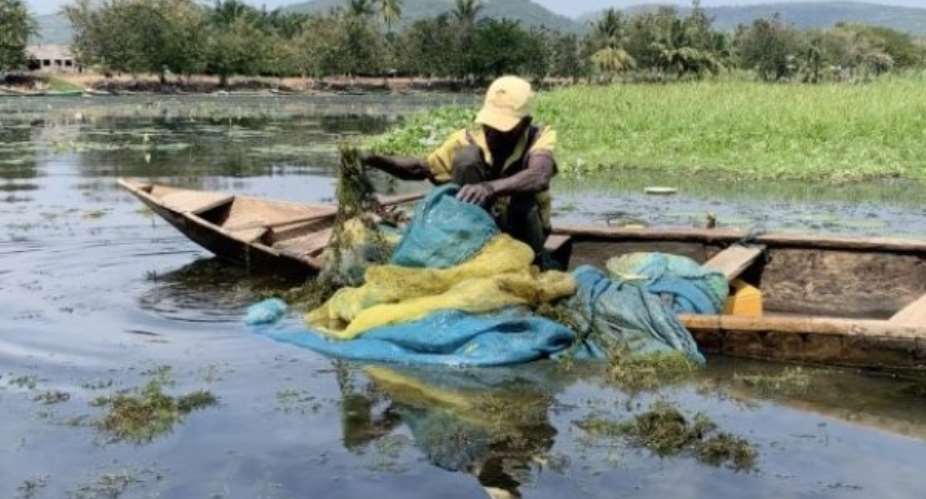The Volta River Authority (VRA) between 2019 and 2021 incurred a revenue loss of GHc 4.1million due to aquatic weeds, particularly, water hyacinth.
The weeds entangle the turbines, making it difficult for them to operate at optimum level.
Water hyacinth, also known as the 'Florida devil', and locally as, 'Poison flowers' one of the world's worst aquatic weeds, is native to the Amazon basin.
It grows on surfaces of rivers, lakes, and other water bodies, forming very thick layers and depriving other living organisms under the mats of sunlight.
Dr Michael Dade, the Manager of Public Health of the Authority at the Kpong Water Head Pond of the VRA, told the GNA, that the extent of the aquatic weeds invasion on the Volta Lake could be likened to 100, the size of the Accra Sports stadium.
He explained that often, when the mat of weeds broke off and got into the turbines, the weeds entangled the turbines, and disrupted operations by reducing the efficiency of the turbines.
In extreme cases, he said they were forced to shut down the affected generating plant unit at the Akosombo Hydro Dam.
Dr Dade mentioned that the beautiful but very invasive plant also caused sedimentation and doubled water loss of the Dam's reservoir.
“The presence of the water hyacinth causes more evapotranspiration of the water reservoir, which is essentially needed to keep the hydro-electric power generating plants in operation,” he said.
“Already the impact of climate change observed in Ghana over the years has made it impossible and difficult to predict the volume and pattern of rainfall; it is erratic in nature.”
The Authority, over the years, he said had worked with the Environmental Protection Agency, Ghana Maritime Authority, and other actors to adopt an integrated approach towards managing the weeds, but it had not been successful.
Dr Dade noted that VRA was working on a project with a private firm to explore the option of harvesting the plant and converting it into a viable commodity.
In recent times, researchers and development workers are harvesting water hyacinth to develop products, including animal feed, artifacts, and compost fertilizer.
Water hyacinth was first noted at a residence in Tema in 1984 and spread to Accra through the activities of horticulturists and flower vendors.
It was subsequently found in the Volta and Tano Lake.
GNA





 There’s nothing you can do for us; just give us electricity to save our collapsi...
There’s nothing you can do for us; just give us electricity to save our collapsi...
 Ghanaian media failing in watchdog duties — Sulemana Braimah
Ghanaian media failing in watchdog duties — Sulemana Braimah
 On any scale, Mahama can't match Bawumia — NPP Youth Organiser
On any scale, Mahama can't match Bawumia — NPP Youth Organiser
 Never tag me as an NPP pastor; I'm 'pained' the 'Akyem Mafia' are still in charg...
Never tag me as an NPP pastor; I'm 'pained' the 'Akyem Mafia' are still in charg...
 Your refusal to dedicate a project to Atta Mills means you never loved him — Kok...
Your refusal to dedicate a project to Atta Mills means you never loved him — Kok...
 2024 elections: I'm competent, not just a dreamer; vote for me — Alan
2024 elections: I'm competent, not just a dreamer; vote for me — Alan
 2024 elections: Forget NPP, NDC; I've the Holy Spirit backing me and nothing wil...
2024 elections: Forget NPP, NDC; I've the Holy Spirit backing me and nothing wil...
 2024 elections: We've no trust in judiciary; we'll ensure ballots are well secur...
2024 elections: We've no trust in judiciary; we'll ensure ballots are well secur...
 Performance tracker: Fire MCEs, DCEs who document Mahama's projects; they're not...
Performance tracker: Fire MCEs, DCEs who document Mahama's projects; they're not...
 Train crash: Railway ministry shares footage of incident
Train crash: Railway ministry shares footage of incident
